Some of my better lego machines
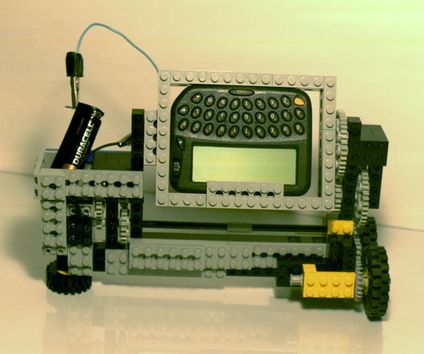
The pager rotating machine | 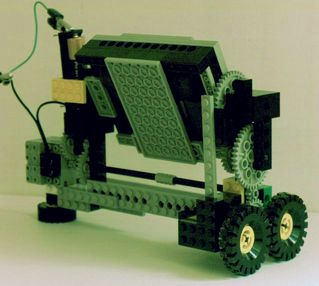
Machine in action |
This machine got me playing with lego again. Back in 1998, I wanted to devise a systematic method for measuring how well the pager did in a certain environment. Because there are always variations as the pager is moved due to the RF fading environment, I decided to average this out by moving the pager through a predefined pattern.

Taking readings on a debugging trip to New York |
I had already devised a wooden machine to do this, but the machine was too bulky to take with me when traveling to different locations by airplane.
Having seen how smoothly and efficiently the newer lego motors run, I knew that one of these motors, geared down with lego gears, would be an ideal power source for a portable battery operated machine. Of course, why stop at just using a lego motor and gears? So I built a new smaller machine entirely out of lego, and expensed the lego.
The machine rotates the pager about a horizontal axis, as well as a vertical axis. The vertical axis rotation is accomplished by having one side of the machine drive around a central pivot on which the other side of the machine rests. The machine drives a full circle every couple of minutes.
I was able to produce surprisingly repeatable measurements of the RF environment
with this gadget, and with some custom software on the blackberry, was even able
to measure the sensitivity of the base stations and verify the accuracy
of the "link budget" calculations.
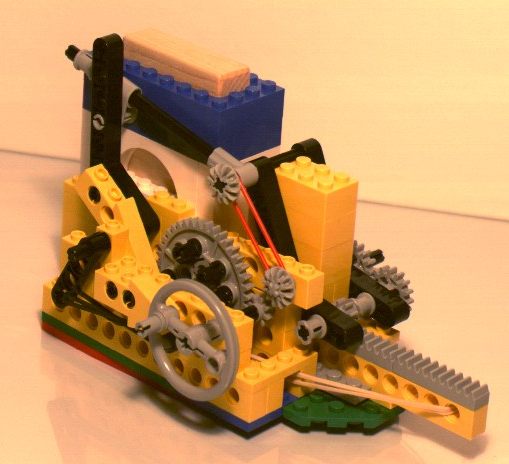
Lego machine gun
The trick with building a lego machine gun is that lego is just not strong enough to build a cam that pulls back the bolt and lets it go. The shafts are too thin for the torque, and the knobs don't hold very well under impacts.
This machine gun is relatively good in that it puts relatively little stress on the lego pieces. The machine works by pulling the 'bolt' and rubber band back with a rack and pinion mechanism. Once the bolt is pulled far enough, the pinion is pulled away from the rack, letting it release and shoot the block.
The cool part is the cam that causes the pinion to be pulled up. The 40 tooth gear has 6 of the 8 holes occupied by connecting pieces. When the space without the connecting piece goes by the cam, the lever in the back snaps back, and pulls the front lever back, releasing the pinion spontaneously. This pulls the pinion out suddenly. If it weren't pulled out with a snapping action, the pinion would rub against the rack because the bolt would shoot forward as soon as it the pinion is high enough to let it slip.
I used wooden blocks for the ammo, because I kept loosing the lego ammo, and I didn't have enough smooth lego plates to build a lot of lego ammo to begin with. Aimed 45 degrees up, it only shoots about a meter and a half before it hits the table again. Still, for the size of projectile, it's not bad.
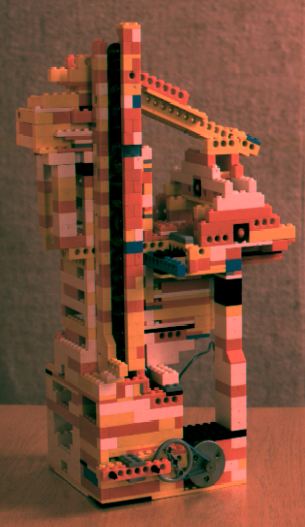
The lego marble machine
This machine was the precursor to subsequent Marble Machines. Back at Christmas 1996, while my brother Markus and I pulled out the old lego again, my brother Markus posed the problem of building a marble elevating contraption that elevated marbles by pumping them up a stack. After several iterations of experimentation and creative collaboration, Markus built a very clever little pumping mechanism that ran very smoothly and reliably. The logical next thing was of course to see how high the marbles could be pumped, and then to think of creative ways of getting them back down again.
I built this stack where the marbles kept bouncing off roof tiles in a circular manner. The marbles descended slowly, while making a great deal of noise. Next, I experimented with building a 'flip flop', which would divide the stream into two alternating streams of marbles. The extension on the right is three of these flipflops. It is fed through the slanted ramp, which, using another flipflop, gets half the marbles, while the other half descends through the rattling column behind the vertical column where the marbles get pushed up.
We let this machine run for quite some time, just showing it to all kinds of people. I later added a second auxiliary pump and other gadgetry to it, but with all the extra junk added to it, it had a tendency to be unreliable.
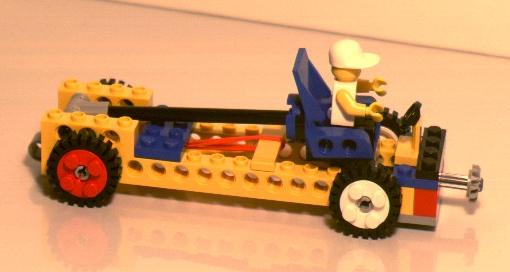
The car with the ejection seat
This is a prototype of an innovative safety system that is much better than seat belts and airbags.
Instead of trying to cushion the accident, wouldn't it make sense to remove the driver from the scene of the accident altogether? Well, this prototype vehicle solves this problem.
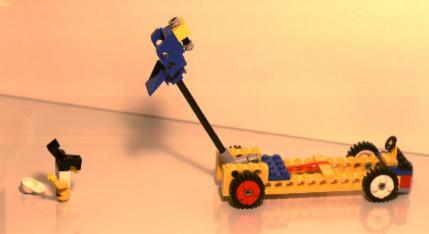
The passenger is safely removed from harm's way
Whenever something is hit at the front, the ejector seat ejects. This photo is actually a bit misleading. In real life, the driver gets ejected more than one meter behind the car.
There is still a bit of a problem when an object is hit at high speed. In that case, the driver is ejected more forward than back, as he is already slipping off the seat by the time it goes off. Further refinement may still be necessary. Maybe a stronger rubber band would do the trick.
When I was a kid, I built a lego ejector seat car that was powered by a fire cracker. This one propelled the passenger way up, but was prone to disassemble itself. Also needed a match to be activated.
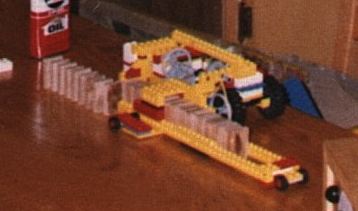
Domino row building machine
I built this machine way back in 1985, before I owned a camera to take pictures of stuff with, and my mom's is of the 'focus free' (unfocusable) variety. Hence the fuzzy image.
I had done a lot of experimenting with building machines to build domino rows for knocking down. My initial experiments all involved dropping the dominos from a magazine that held the dominos slightly above the table. This didn't work to well, because some of the dominos would bounce and fall over, knocking over the whole row. This machine works by basically dragging all the dominos along the table, and pushing them aside one by one. This doesn't involve dropping, so it doesn't cause accidental tipping of dominos. I was very proud of this machine, but my brother Markus could still set them up faster, although not as neatly.
Update:
I have since rebuilt the machine from memory and posted a more detailed article
and video on the
domino row building machine
Lots more interesting Lego machines
on Philo's home page.
To my Home page